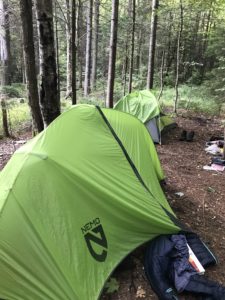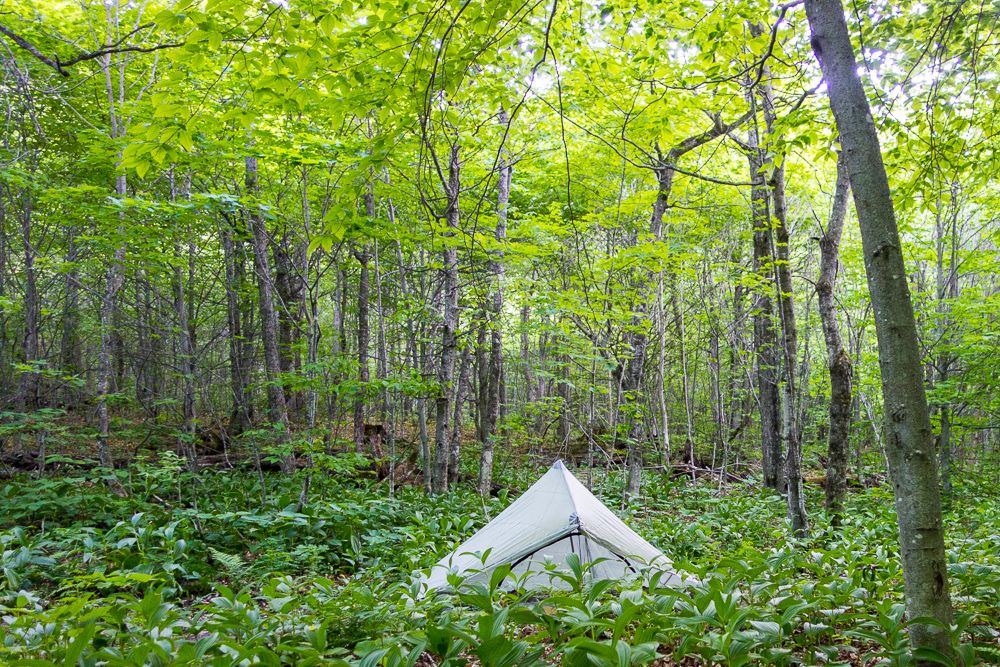 One of the many amazing aspects of the Long Trail is its shelter and privy system. With over 70 designated overnight sites, you can plan to reach a shelter every night, but sometimes things don’t go according to plan; you may have pushed yourself too far and are not able to make it to the next shelter; or maybe a shelter is full; or you may prefer peace and solitude over a busy overnight site. This leads you to primitive camp, also known as “no trace camping” or “dispersed camping.” The Vermont Agency of Natural Resources defines primitive camping as “camping in a forest with no developed facilities and leaving the site with little or no evidence of human visitation.” Here is everything you need to know about primitive camping along the Long Trail:
One of the many amazing aspects of the Long Trail is its shelter and privy system. With over 70 designated overnight sites, you can plan to reach a shelter every night, but sometimes things don’t go according to plan; you may have pushed yourself too far and are not able to make it to the next shelter; or maybe a shelter is full; or you may prefer peace and solitude over a busy overnight site. This leads you to primitive camp, also known as “no trace camping” or “dispersed camping.” The Vermont Agency of Natural Resources defines primitive camping as “camping in a forest with no developed facilities and leaving the site with little or no evidence of human visitation.” Here is everything you need to know about primitive camping along the Long Trail:
The Long Trail crosses private, state, and federal land. Primitive camping along the trail can be complicated because the rules vary depending on who the land manager is:
Private Land
Camping is limited to designated areas on specific private lands only and not allowed on other private lands. Fires are limited to permanent fireplaces at each site. Use of this land is permitted through the generosity of the landowners. Please do not abuse the privilege. Please familiarize yourself with land ownership prior to planning your outing.
State Land
In certain state forests, primitive camping is allowed, but your campsite must be 100’ from any water source, 200’ from any trail or property line, 1000’ from any traveled road, and below 2500’ in elevation.
Federal Land
Camping between shelters is permitted along much of the LT in the Green Mountain National Forest (GMNF). GMNF recommends campsites be at least 200’ from any water source or trail, and not to camp in the alpine zones.

Figuring out who the land manager is can be the most complicated part of primitive camping. Most state land is found just north of Mount Ellen, which includes Camel’s Hump State Forest, Mount Mansfield State Forest, and Jay State Forest. Most federal land is found south of Mount Ellen. Private land is found in small pockets throughout the trail. As a side note, most of the Appalachian Trail from Killington to the New Hampshire border is found on a narrow strip of federal land surrounded by private land. There are a few areas of state land along this stretch as well.
The Long Trail Guide is a good resource for figuring out what land each area of trail crosses. When in doubt, please camp only in designated areas and avoid building fires.
Wherever you choose to primitive camp, following Leave No Trace principles is important:
- Plan ahead and prepare
- Travel and camp on durable surfaces
- Dispose of waste properly
- Leave what you find
- Minimize fire impact
- Respect wildlife
- Be considerate of other visitors
Leave No Trace offers specific guidelines for camping in “undisturbed remote areas” to make sure you create as little an impact as possible, and don’t forget to clean up your campsite when you leave so that it looks like no one was ever there:
Pristine areas are usually remote, see few visitors and show no obvious impacts. Visit these special places only if you are committed to, and highly skilled in, Leave No Trace techniques. In pristine places, it is best to spread out tents, avoid repetitive traffic routes and move camp every night. The objective is to minimize the number of times any part of the site is trampled. In setting up camp, disperse tents and the kitchen on durable sites. Wear soft shoes around camp. Minimize activity around the kitchen and places where packs are stashed. The durable surfaces of large rock slabs make good kitchen sites. Watch where you walk to avoid crushing vegetation and take alternate paths to water. Minimize the number of trips to water by carrying water containers. Always check regulations, but camping 200 feet (70 adult steps) from water is a good rule of thumb.
When breaking camp, take time to naturalize the site. Covering scuffed areas with native materials (such as pine needles), brushing out footprints, and raking matted grassy areas with a stick will help the site recover and make it less obvious as a campsite. This extra effort will help hide any indication where you camped and make it less likely that other backcountry travelers will camp in the same spot. The less often a pristine campsite is used the better chance it has of remaining pristine.
For those seeking a remote backcountry experience that are also willing to put in the extra effort to follow land management rules and Leave No Trace guidelines, primitive camping can be an exciting and fulfilling adventure.



















I don’t think 70 steps is 200 feet. Each adult step is probably 1.5 feet. 70 PACES (2 steps, one each with right and left feet) would be more like 200 feet. Of course many people do not know the difference between paces and steps, so I guess that’s what happened here: someone wrote “paces” and someone else edited to “steps”. Should be 70 paces for 200 feet.